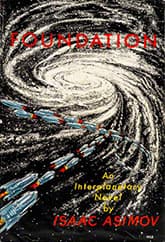The Foundation Trilogy
Critique • Quotes • At the movies
 First edition
First editionOriginal trilogy:
• Foundation, 1951
• Foundation and Empire, 1952
• Second Foundation, 1953
Later sequels:
• Foundation Edge, 1982
• Foundation and Earth, 1986
Later prequels:
• Prelude to Foundation, 1988
• Forward the Foundation, 1993
First publication
Published as stories in Astounding Science Fiction magazine
First book publication
1951 (Foundation)
Literature form
Novels
Genres
Science fiction
Writing language
English
Author's country
United States
Length
Foundation approx 70,500 words, trilogy approx. 220,000 words

Psychohistorian Hari Seldon and protégée Gaal Dornick plot to protect the Foundation.
A new foundation
Foundation (2021–2023): Television series, 20 episodes of about an hour each; directors David S. Goyer, Alex Graves, Roxann Dawson, and others; writers David S. Goyer, Josh Friedman and others; featuring Jared Harris, Lee Pace, Lou Llobell, Leah Harvey, Laura Birn, Terrance Mann, Alexander Siddig
How could the standout novel series of science fiction's Golden Age be adapted into a film or video series? As author Isaac Asimov noted, the Foundation books were cobbled together from short stories spanning millennia of galactic developments with generations of characters spending their time talking and working out intellectual problems. No space battles or alien confrontations that characterize most scifi on the large and small screen.
But what veteran SF screenwriters David S. Goyer and Josh Friedman came up with for the first two—and counting—seasons of the Foundation television series was brilliant. They managed to create a visually exciting, emotionally stirring and still cerebrally engaging television series from Asimov's placid storylines.
Sure, they had to depart from some of the famous writer's core ideas, which horrified some readers, but it's hard to see the series succeeding without such compromises.
The cleverest moves may be how the series creators got around the continual changing of characters over the galactic timescales.
Instead of having a succession of different emperors overseeing the rise and decline of the Galactic Empire, they have the reigning dynasty represented throughout the immensely long time period by essentially the same emperor. By clones of the original emperor Cleon I, to be exact. At any given moment the empire is headed by a Troika of cloned siblings: a child called Brother Dawn, a man at his potent peak called Brother Day, and a senior called Brother Dusk. As time passes, Dawn grows into the next Day, Day ages into Dusk, and Dusk eventually dies to make way for another infant clone Dawn, and the cycle continues. When the Foundation series begins we're in the twelfth go-round of this cycle.
Every generation of Cleons is aided by the ageless Demerzei, one of Asimov's positronic-brained androids. Think Star Trek's Data but female and with secret feelings. She is effectively played by Finnish actress Laura Birn, especially when she's engaging some incarnation of Brother Day, always portrayed by American actor Lee Pace. Pace himself is magnetic in the emperor role.
But his nemesis, the psychohistorian Hari Seldon is only a slightly less formidable presence. Jared Harris, best known for his role as the strait-laced British financial officer on Mad Men, brings Asimov's reclusive Seldon into the limelight in the Foundation series. Instead of just appearing periodically as a ghostly hologram to deliver predictions, as he does in the books, Seldon is fleshed out as a character mysteriously taking part in the ongoing interplanetary intrigues. How this is managed is too tricky to explain succinctly but Harris makes the most of his screen time to make Seldon the putative star of the show.
The writers also turn Seldon's protégée from the beginning of Asimov's tale, Gaal Dornick, into a mainstay of the series, with the help of suspended animation and time jumps. Dornick is also now a woman, played by Lou Llobell. She turns out to be the mother of Salvor Hardin, a hero of the first book in Asimov's trilogy and also now a woman in the series. The two end up working together, more or less.
The official trailer for the Foundation television series.
The first season of Foundation— with all these clones, holograms and time jumps—can be disconcerting, even for those familiar with the original books. A lot of complaints were made in the show's early days. But by the second season, the confusion clears. The stories and characters draw viewers deeper into Asimov's galaxy-spanning epic.
What the author might not have appreciated if he were still around is how much mysticism has crept into the story. Asimov was a practitioner of "hard" science fiction and a science popularizer critical of religious and other paranormal claims. I don't know whether he would recognize the need to make the Foundation story more palatable for a believing public. But as a skeptic myself I don't begrudge the filmmakers a little mystical licence to help bring the whole magnificent sweep of Asimov's story into existence.
And a magnificent spectacle it is on the television screen too. The special effects are sumptuous and otherworldly. But the filmmakers never seem to be throwing money around to cover other deficiencies, as we sometimes see in science fiction extravaganzas. The effects always appropriate to supporting the story and building the worlds we'd like to spend time in.
We'll see if this continues as we enter successive seasons.
— Eric


